URC Update | November 2022
2022 Seattle Cooper’s Hawk Project: Annual Report
Last year we reported that the Seattle Cooper’s hawk population continues to grow no matter what the obstacles. This year, for the first time in the 11 years of our study, we recorded a downturn in the population. Potential culprits include the long, cold, wet spring, the local emergence of highly pathogenic avian influenza (HPAI), and the possibility that the Seattle Coop population is getting close to carrying capacity.
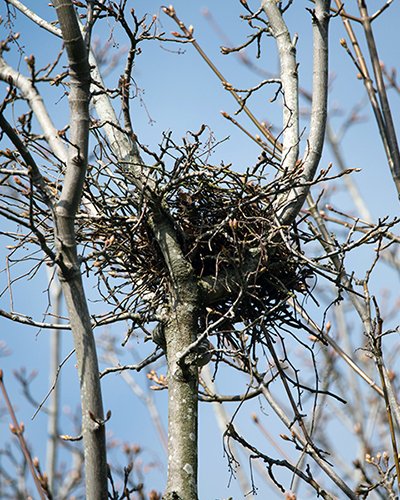
Stick nest, March 2022. It begins. (John Gossman)
Nest collapses took a toll; three pairs lost their nest and only one of them renested. Predation was also significant. One nest lost its eggs to raccoons, another lost a nestling to a red-tailed hawk, and at a nest in Magnuson Park, three chicks vanished overnight (barred owl? raccoon?).
The most common trees used for nest-building were perennial favorites bigleaf maple (17), Douglas-fir (14), and white pine (8). As the climate changes, we expect changes in relative abundance of nest tree species. For example, in recent years both bigleaf maples and Western red cedars are experiencing diebacks.
Regardless of the explanation, this was a strange year, with unprecedented turnovers during courtship and nest-building. We documented at least 17 turnovers of birds on nesting territory, versus six in 2021. Two banded females that were replaced were later found nesting at new locations. Both females had successfully nested in 2021. Why did they leave? Were they driven off by another female or did they leave by choice? Ed Deal witnessed one such probable turnover, a lengthy and nasty fight between two females over ownership of a nesting territory in a park.
By the numbers:
- 61 nest-building sites, with 70 nests (Coops sometimes build more than one nest per site before choosing one). As is typical, the majority of the 61 nests were in Seattle parks and greenbelts (38), followed by private property (18), cemeteries (3), and the University of Washington campus (2).
- 48 successful nests fledged 167 young (in 2021, 52 nests fledged 192 young).
- 14 active nest sites in 2021 were not active in 2022.
- 13 active sites failed, including from predation: six were abandoned during nest building, four failed during incubation; and three failed after hatching.
- 8 nest sites were discovered only after young had fledged. We always miss a few early on.

13-year-old male E-V, “Old Blue”, the oldest Cooper’s hawk in our study (Larry Gilpin)
In May, Ed Deal gave a one-hour talk on the Cooper’s hawk for the Washington Ornithological Society. It’s all archived here.
Ed also published an extensive review of our region’s Cooper’s hawks: The Cooper’s Hawk: History and Current Status in Washington. Washington Birds, 13, 81-96.
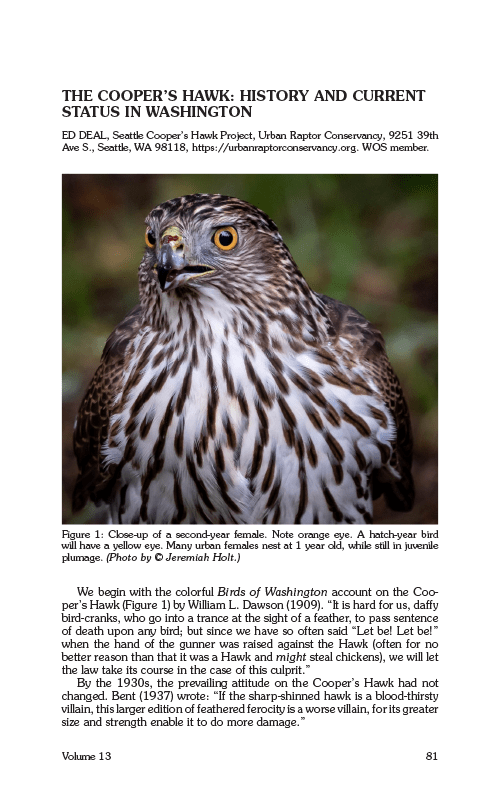
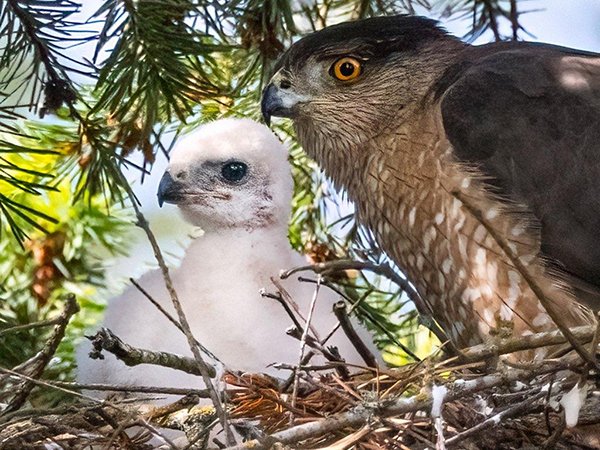
Adult and nestling (Larry Gilpin)
Banding Report

Robin Melvin
In 2022, our diligent banding parties and volunteer assistants devoted many hours to put jewelry (colorID bands) on 60 Cooper’s hawks, mostly fledglings. Another nine rehabbed Coops were banded and released by PAWS Wildlife Center. One positive result of the Covid pandemic is that people working from home have been attending to their backyard bird feeders as well as their laptops. To date we have logged a robust 130 band sightings in 2022. In 2021, the final tally was a record 164 reports, which trounced the previous best year of 94 in 2020.
Since 2011 our team has banded 491 Cooper’s Hawks, of which 226 were seen again, a fine return rate of 46%. Of these banded hawks:
- 72 are known dead, with window hits, as usual, the most common cause of death (25)
- 40 were successfully rehabilitated birds at PAWS (thanks, PAWS!), with a decidedly skewed gender (12 males, 28 females). Twelve (30%) of these rehabbed hawks have been since sighted alive.
Over the last 11 years, we have logged over 600 band sightings, when a Coop’s band is read by a keen-eyed observer. This feat is made possible only from public observations: we band them, but it’s up to the rest of the world to find them again. Thanks to all of you informants.
Notable Band Sightings
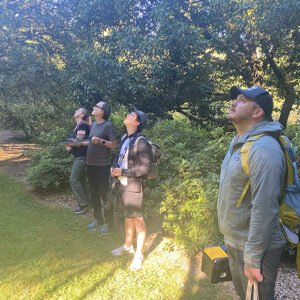
The Rapture: Early-morning URC field assistants watching fledglings in the Arboretum (Patti Loesche)
“Old Blue” (banded blue E-V), the last known surviving Coop banded by study founder Jack Bettesworth, had yet another successful year. At 13 years old, he has successfully nested for 12 consecutive years and fledged 45 young, a likely world record. We hope that he has a few more good years left. Okay, we all hope for that.
Most dispersing Cooper’s hawk fledglings in Seattle later set up nesting territories nearby. Since this study began, only two band sightings have been south of Tacoma. In fall 2015, a juvenile female from Volunteer Park (orange right 3-K) was spotted in Lake Merritt, Oakland, California, by a birder who had spent the summer on a field study reading color bands on song sparrows. Reading the Coop’s relatively huge color bands was a snap by comparison. The second Coop long-disperser was juvenile female orange right B-3, banded as a fledgling at Miller Park, our most urban nest site. In October 2021 she was filmed at an RV park and later found dead in rural Nye County, Nevada, about 200 miles north of Las Vegas. Do Seattle’s urban Cooper’s hawks migrate? Two did.
Is the decline in Cooper’s hawk numbers this year a blip in their steady population growth, or a harbinger of declines to come? This question underscores the importance of long -term population monitoring studies.
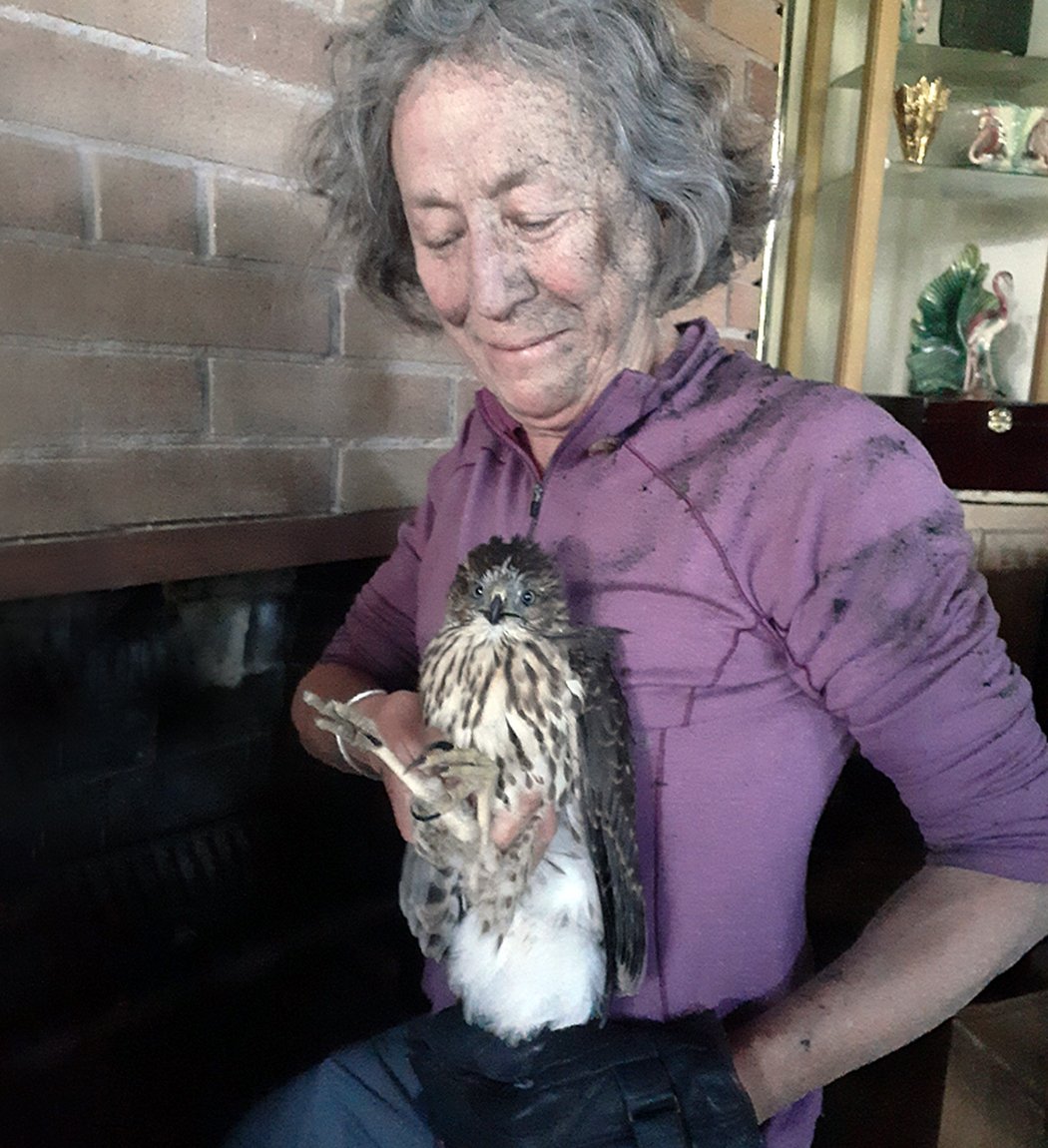
Patti and “Ashley,” 7/22/22 (Chris Phillips)
Chim-Chiminey
This morning I stopped by my neighborhood Coop nest. Before I even got out of the car, a neighbor walked up with a puzzled face and told me he had “one of those hawks” stuck in his chimney, and did I know what he should do. Good question.
I followed him into his house with my carrier. A fledgling Coop was indeed fluttering just on the other side of the fireplace flue. I called Ed for pro tips on chimney rescues. “Good luck!”
I had to fully commit to the effort, but once I was all the way inside the fireplace I could get my arm inside the flue and feel feathers. The Coop had been trying vertical leaps and was pretty tired, but I couldn’t tell if I had room in the flue to get it out. Gloved, I was able to get one tarsus, then the other, and gently rotated them feet forward, hoping to draw the bird out with instead of against its feathers. The bird cooperated by sticking its head out of the flue. Whew, no breech delivery! I worked out one shoulder at a time, then drew out the tarsi, and suddenly Ms. Outrage was in the living room. She is now banded: orange right K-M. I call her Ashley. As I write this, neighbors report that she is back in the nest calling her lawyer.
Patti Loesche
Postscript: We just received a report from the federal bird banding lab that “Ashley” was seen 20 miles north in Lynnwood, Washington, on August 21. Well done, K-M!
Volunteer Profile: Jeff Graham
Another benefit for URC of the COVID pandemic was that Jeff and Marie Graham could not do their annual summer volunteering for the US Forest Service in Idaho. Instead, Jeff joined us in the field in late March 2020 and has spent many hours learning Coop fieldcraft with Martin Muller. He is a tireless photographer. We recognize him here for his observation skills and understanding of Coop behavior. This year he covered eight nests in northeast Seattle, including all four of the Magnuson Park nests, a huge help to our project. Thank you, Jeff!
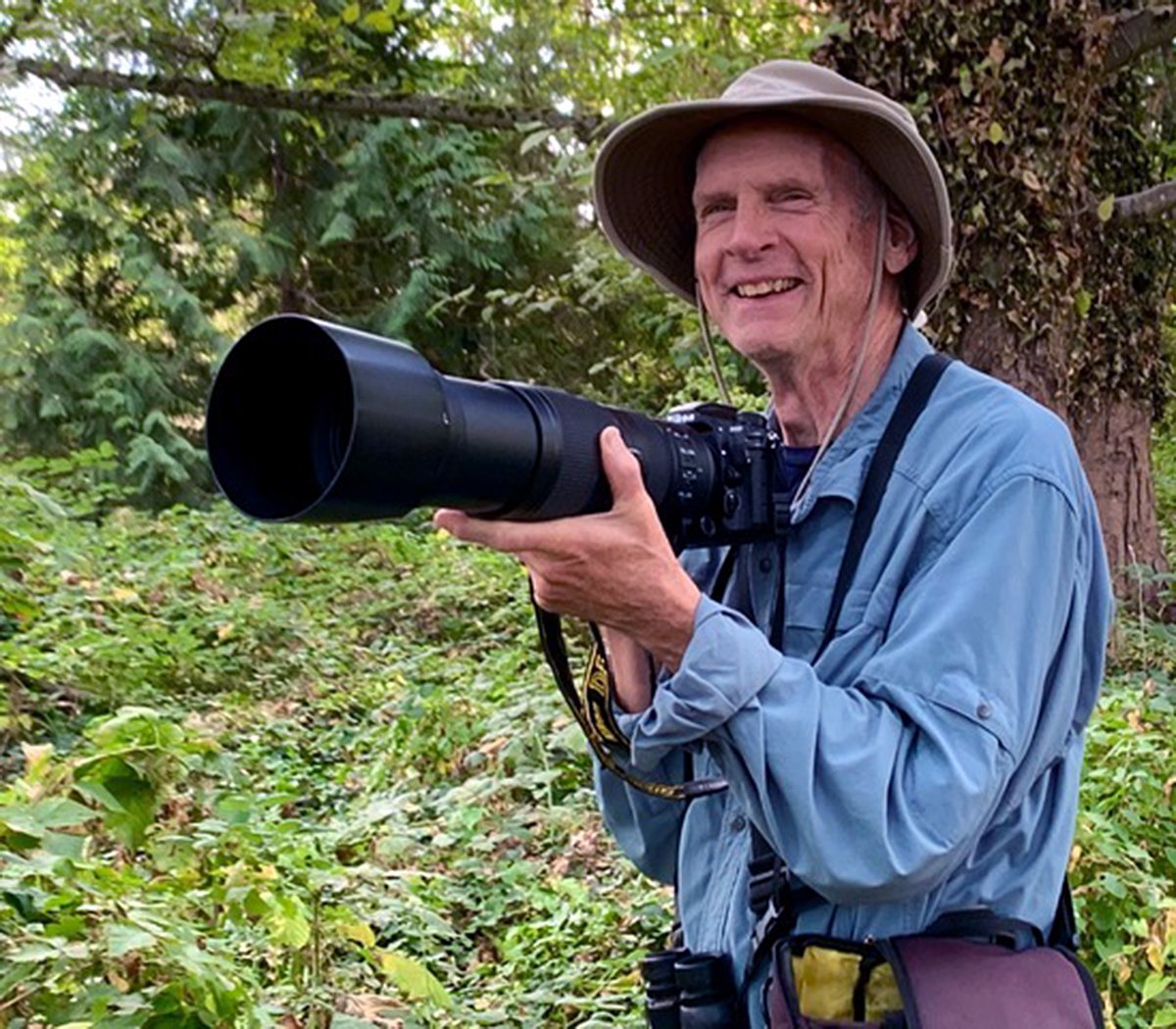
Jeff Graham (Marie Graham)
Jeff’s field observations helped document the rare event of three nesting attempts by a pair of Coops in one season: they failed twice during incubation, then laid a third clutch and succeeded.
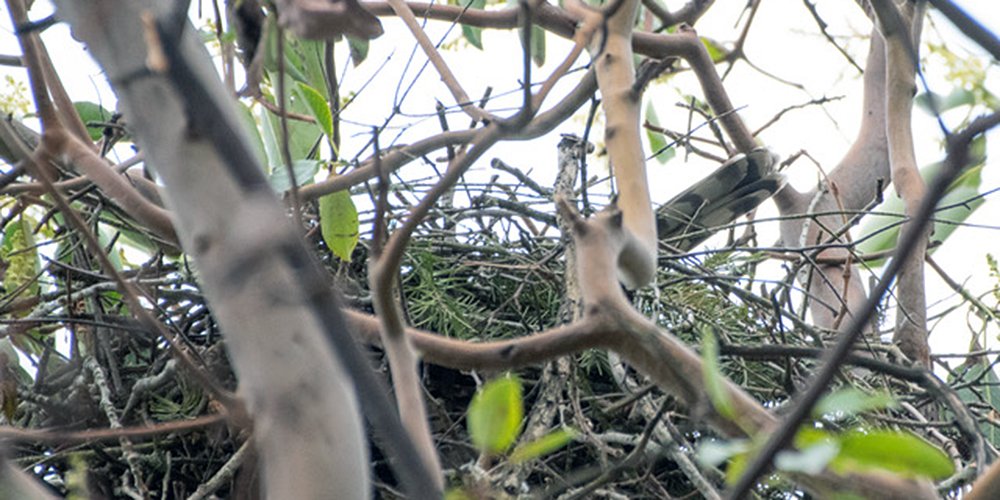
April 20: First nesting attempt at Promontory Point, Magnuson Park. Adult female’s tail is visible (“up”) as she incubates her brood.
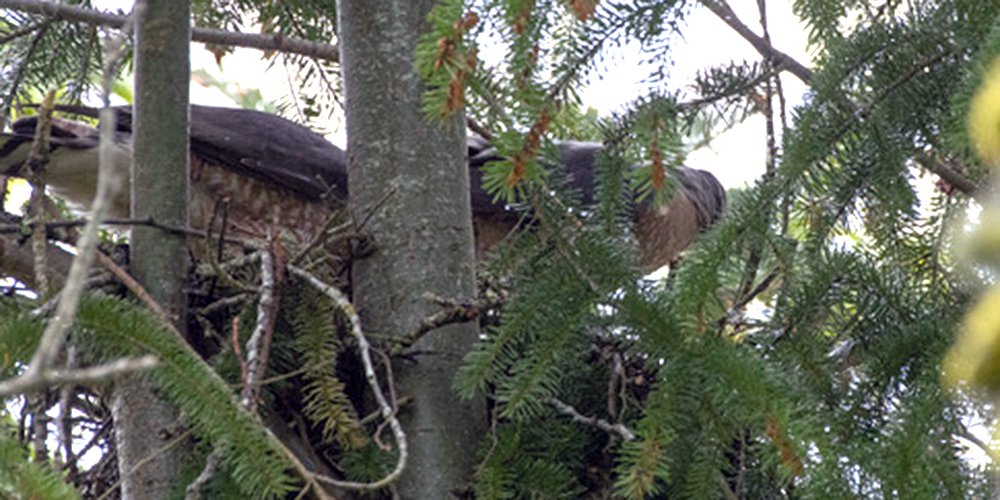
May 6: Adults at work on their second nest attempt after the failure of the first attempt.
Female Cooper’s hawks are larger than males. These siblings show this size differential. (L) Female, (R) male. (Larry Gilpin)
